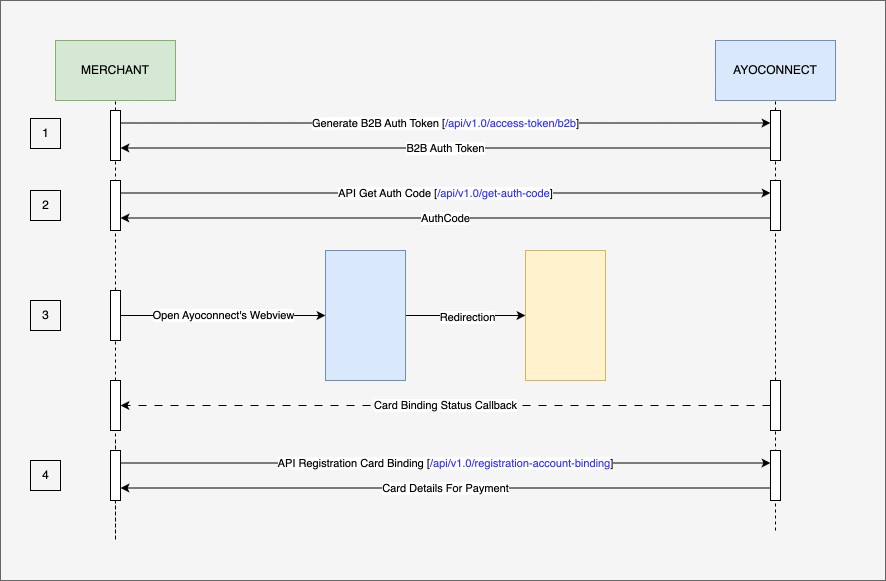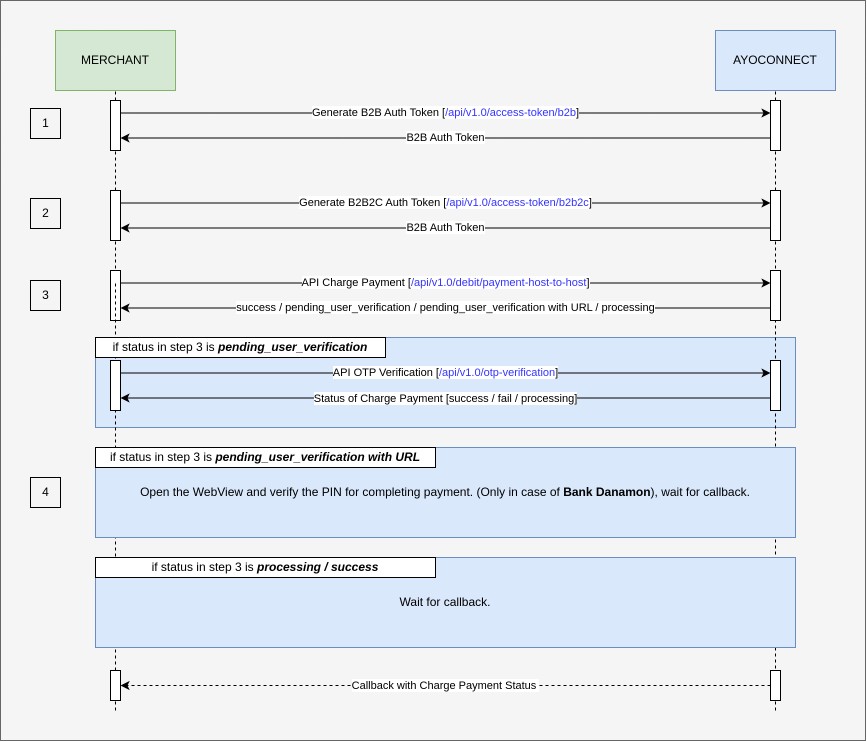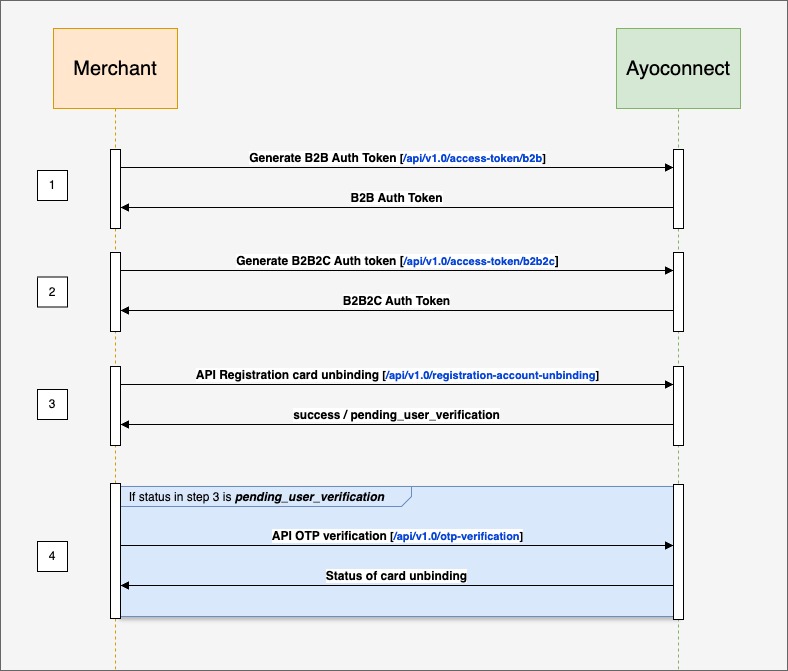API Flows
Direct Debit API Flows
Flows
There is 4 MAIN FLOWS that you can perform using Ayoconnect's Direct Debit Solution:
Flow | Details |
|---|---|
Binding |
|
Payment |
|
Unbinding | Unbind your customer's binded bank account |
Get list of customer's accounts | Get the list of accounts currently to your customer |
Binding Flow
APIs part of this flow:
- Generate B2B Access Token API
- Get OAuth Code API
- Account Binding API
 Partners can follow the below steps to perform a Card Binding:
Partners can follow the below steps to perform a Card Binding:
- Generate a B2B token by calling the Generate B2B Access Token API.
- With the newly generated B2B token, generate a unique
authCodeby calling the Get OAuth Code API. - Replace the
auth_codein the below URL with the value of theauthCodefield from the previous step: https://sandbox.api.of.ayoconnect.id/dd-card-binding?authCode={auth_code} - Open the URL and the bank selection screen will open. Follow the steps mentioned in the UI and complete the Card Binding process. After a successful Card Binding, a callback with the account status will be sent to the registered callback URL. In case of any issue during the Card Binding, a callback will be sent and the client is redirected back to the client app for the failure screen.
- NOTE: the same value used in the
authCodefield in the URL, will be returned in theX-EXTERNAL-IDfield in the callback (partners can use this field to link the callback requests with the accounts bound in the previous step).
- NOTE: the same value used in the
- If the callback isn't received, or you want to reconfirm that the account has been properly bound, you can call the Account Binding API with the same
authCodeused in the previous steps to get theaccountTokenand other details of the card, which can be directly used for payments. - The Binding session (during webview) have expiration time of 3 minutes. This value is configurable from Ayoconnect side based on your business preferences. However we generally do not recommend having session expiration time more than 60 minutes.
- This expiration time is only applicable for when user try to bind the card. If after 3 minutes user still have not successfully bind the card, then the authCode will be expired and partner need to generate new authCode in order to attempt another binding.
- However if the process is successful, then the authCode will be PERMANENTLY associated with the binding itself. Going forward partner will not need to generate new authCode and can use the existing authCode to do payment.
- Ex 1: Partner successfully generated authCode "A" and and authCode "A" expired after 3 minutes since user have not successfully bind their card. Partner will need to generate new authCode and restart the binding process from the beginning.
- Ex 2: Partner successfully generated authCode "B" and user successfully bind the card using authCode "B". Partner can now use authCode "B" to generate B2B2C token used for payment permanently without the need to generate a new authCode for the successfully bound card.
Payment Flow
APIs part of this flow:
- Generate B2B Access Token API
- Generate B2B2C Customer Authorization Token API
- Direct Debit Payment API
- Verify OTP API (only in case of payments that require OTP)
 NOTE: Before you start with this flow, you will need to generate a new value for the X-EXTERNAL-ID header. Don't reuse the same value in different flows.
NOTE: Before you start with this flow, you will need to generate a new value for the X-EXTERNAL-ID header. Don't reuse the same value in different flows.
Partners can follow the below steps to perform a Payment:
- Generate a B2B token by calling the Generate B2B Access Token API.
- Generate a B2B2C token by calling the Generate B2B2C Customer Authorization Token API.
- Use the B2B and B2B2C tokens to generate the request to the Direct Debit Payment API.
- B2B2C API request will have mandatory parameter authCode which partners can populate using the same authCode that is used for the successful binding.
- In case of a payment with OTP, a new call to the Verify OTP API will be required.
- NOTE: Partners shouldn't fail the transaction if the OTP verification is not completed before 3 attempts (the transaction should be marked as failed only after the 3 OTP verification attempts).
- NOTE: After 3 failed attempts, the account will be blocked and the partners should block the customer for that specific bank (to prevent further requests).
- After a payment, a callback should be received by the partners with the status.
- If the callback isn't received, or you want to reconfirm that the payment has been properly confirmed, you can call the Get the Status of a transaction API with the same
X-EXTERNAL-IDused in the previous steps.
Unbinding Flow
APIs part of this flow:
- Generate B2B Access Token API
- Generate B2B2C Customer Authorization Token API
- Account Unbinding API
- Verify OTP API

NOTE: Before you start with this flow, you will need to generate a new value for the X-EXTERNAL-ID header. Don't reuse the same value in different flows.
Partners can follow the below steps to perform the Card Unbinding:
- Generate a B2B token by calling the Generate B2B Access Token API.
- Generate a B2B2C token by calling the Generate B2B2C Customer Authorization Token API.
- Use the B2B and B2B2C tokens to generate the request to the Account Unbinding API.
- In case of a Card Unbinding with OTP, a new call to the Verify OTP API will be required.
Updated 7 months ago